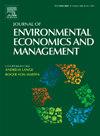Focusing the view: Improved methods for assessing viewshed impacts of onshore wind turbines
IF 5.5
3区 经济学
Q1 BUSINESS
Journal of Environmental Economics and Management
Pub Date : 2024-09-27
DOI:10.1016/j.jeem.2024.103068
引用次数: 0
Abstract
Onshore wind turbine capacity continues to grow and will only accelerate, though siting can be challenging given community opposition. We apply the hedonic valuation method with residential property sales data to assess nearby residents’ willingness to pay to avoid having views of turbines from their property. In doing so, we aim to improve methods of assessing viewshed impacts for turbines and other amenities and disamenities that have a visual component. Our recommended viewshed approach uses a Digital Surface Model (DSM), which accounts for trees and buildings that obstruct views. For comparison, we also create viewsheds based on bare-earth Digital Elevation Model (DEM), which has been more typically used other studies. Using data from New England, USA, we use a difference-in-differences identification strategy with treatment defined by the visibility of a wind turbine, while also controlling for proximity-based treatment effects. The results suggest that property values decline by 2.2%–2.5% when a wind turbine is visible, with larger impacts in urban and coastal areas. DEM methods misclassify viewshed for about 75% of properties, when compared to the DSM-based viewshed, and the resulting DEM-based valuation estimates are attenuated.
聚焦视野:陆上风力涡轮机对景观影响的改进评估方法
陆上风力涡轮机发电量持续增长,而且只会加速增长,但由于社区的反对,选址可能具有挑战性。我们将保值估值法与住宅物业销售数据相结合,评估附近居民为避免从其物业看到涡轮机而付费的意愿。这样做的目的是改进涡轮机和其他具有视觉效果的便利设施和不便利设施的景观影响评估方法。我们推荐的视角方法使用数字地表模型 (DSM),该模型考虑了阻碍视线的树木和建筑物。为了进行比较,我们还根据裸地数字高程模型(DEM)创建了景观区,这种方法在其他研究中更为常用。利用美国新英格兰地区的数据,我们采用了差分识别策略,以风力涡轮机的可见度来定义处理,同时还控制了基于邻近性的处理效应。结果表明,当风力涡轮机可见时,房产价值会下降 2.2%-2.5%,对城市和沿海地区的影响更大。与基于 DSM 的视角相比,DEM 方法对约 75% 的房产进行了错误的视角分类,由此得出的基于 DEM 的估价也有所减弱。
本文章由计算机程序翻译,如有差异,请以英文原文为准。
求助全文
约1分钟内获得全文
求助全文
来源期刊
CiteScore
8.00
自引率
4.30%
发文量
91
期刊介绍:
The Journal of Environmental Economics and Management publishes theoretical and empirical papers devoted to specific natural resources and environmental issues. For consideration, papers should (1) contain a substantial element embodying the linkage between economic systems and environmental and natural resources systems or (2) be of substantial importance in understanding the management and/or social control of the economy in its relations with the natural environment. Although the general orientation of the journal is toward economics, interdisciplinary papers by researchers in other fields of interest to resource and environmental economists will be welcomed.

 求助内容:
求助内容: 应助结果提醒方式:
应助结果提醒方式:


